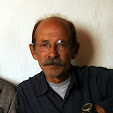Background.
On August 3, 2014, the Islamic State (Daesh) attacked the isolated
and defenseless Yezidi population in the Sinjar region of northern
Iraq. Fueled by souless depravity thinly guised by Islam, they
killed, kidnapped, and destroyed, making refugees of hundreds of
thousands of Yezidis. Several thousand of the kidnapped remain in
the hands of Daesh, and thousands more in the Iraqi city of Mosul are
still under its control. Daesh was militarily defeated first on
the north side of Sinjar Mountain, and in late-2015 Sinjar City and a
swath of territory at the foot of the south side of the mountain was recaptured after fierce
fighting. As of the spring of 2017, only a very very few refugees
have returned to the Sinjar.
This is the first part of three. The others continue below. For more photographs and writings about the Yezidis in the Sinjar, visit the 2012 and 2015 postings in this blog. A 5-minute slideshow entitled "What Was Lost in the Sinjar" can be seen by clicking on its link. And finally, you are invited to visit Beyond Borders Photography for a more expansive collection of photographs of the Yezidis.
---------------- o ---------------
The
early evening light was soft as Gharbi and I walked the abandoned
lane to his house in Zorava.
The last time I was here 3 years ago it
was alive. We rounded the corner and arrived at Gharbi's house,
since defiled by Daesh (ISIS) in 2014. A rare neighbor grazed a small flock
of sheep in what used to be the garden, sharply yelling at the dog
doing its job.
The walls of the homes in the compound still stood,
but the roofs were destroyed and the rooms ravaged. I paused. The
reception room where I had spent uncounted hours over the years
looked unnervingly small now filled with rubble. Nature was already
restoring its primacy. But for Gharbi, no sentimentality. He had
returned before, both to this home and to this place and to this
time. In his 62 years this was the fourth time he was forced from
his home. He is a Sinjari Yezidi of northern Iraq.

I
returned to the Sinjar (Shingal regionally) to photograph some of the shrines destroyed by Daesh, the shrines that I had
photographed over the preceding years. It seemed important to me, and
I hoped important to the Yezidis and others concerned with such
matters. Correctly the world was horrified at the souless and savage killing of
Yezidis, the kidnapping of women and children, the tsunami of
refugees. But now, 2-1/2 years later there is some space for this story.
We recoiled
at the enthusiastic destruction of world heritage ruins
at Palmyra, Syria and Nimrod, Iraq, and others. But none have yet to
recognize the destruction of the Yezidi shrines in Shingal, the
centers of community and belief.
The
shrines on the north side
of Sinjar Mountain remain untouched by Daesh,
except for the diminutive Sheikh Romi, whose wobbly spindle of a spire was unique being without the distinctive and iconic flutes.
|
|
Sheikh Romi Shrine - 2012
A collection of Kurdish
forces flying different flags united to drive Daesh
out before they could destroy the others.
|
We
drove along the road that skirted the gentle apron of the mountain,
now green with spring grasses but nearly void of Yezidis at a time it should have been dotted with flocks of sheep.
Although the north side was militarily resecured, only the most stubborn,
strong, or desperate of the infamously strong and stubborn Sinjari Yezidis have returned. The destroyed buildings spoke to
the Daesh's manic
destruction during its brief occupation and the ensuing fighting. The flat
concrete roofs, where not pancaked, draped to the ground like broken
wings.
We
pulled off the roadway. I recognized the cemetery. I saw the low
knoll. I did not see the Sheikh Romi shrine. Its absence took my breath away.
Walking to the place of what was no longer, I remembered stooping
low to enter through its arched doorway with Gharbi and his son
Faisal. I remembered its musty darkness.
The hollow of the single
room remained, partially filled with unsettled rubble. The niche
where the gazelle horn rested was there. Gharbi found the horn, and
he held as he had before so I could take a picture, now open to the
sky.
 |
| Ruins of the Sheikh Romi Shrine (April 2016) |
How do you photograph what is not there?
 |
| Site where Sheikh Romi shrine once stood. (April 2016) |





























